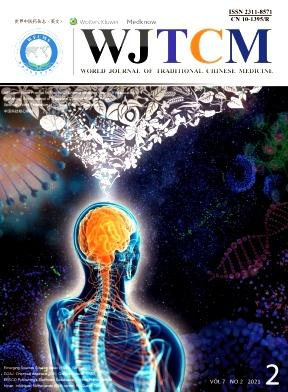Investigating the Mechanism of Qu Du Qiang Fei 1 Hao Fang Formula against Coronavirus Disease 2019 Based on Network Pharmacology Method
IF 4.3
3区 医学
Q1 INTEGRATIVE & COMPLEMENTARY MEDICINE
引用次数: 0
Abstract
Qu Du Qiang Fei 1 Hao Fang (QDQF1) is a novel Chinese herbal medicine formula used to treat coronavirus disease 2019 (COVID-19). However, the pharmacological mechanisms of action of QDQF1 remain unclear. The objective of this study was to identify the effective ingredients and biological targets of QDQF1 for COVID-19 treatment. The effective ingredients and mechanisms of action of QDQF1 were analyzed by using network pharmacology methods, which included an analysis of the effective ingredients and corresponding targets, COVID-19-related target acquisition, compound-target network analyses, protein-protein interaction network analysis, Kyoto Encyclopedia of Genes and Genomes (KEGG) and Gene Ontology (GO) enrichment analyses, and molecular docking studies. In total, 288 effective QDQF1 ingredients were identified. We identified 51 core targets from the 148 targets through an overlap between putative QDQF1 targets and COVID-19-related targets. Six key components, including formononetin, kaempferol, luteolin, naringenin, quercetin, and wogonin were identified through component-target network analyses. GO functional enrichment analysis of the core targets revealed 1296 items, while KEGG pathway enrichment analysis identified 148 signaling pathways. Nine central targets (CCL2, CXCL8, IL1B, IL6, MAPK1, MAPK3, MAPK8, STAT3, and TNF) related to the COVID-19 pathway were identified in the KEGG pathway enrichment analysis. Furthermore, molecular docking analysis suggested that the docking scores of the six key components to the nine central targets were better than those to remdesivir. QDQF1 may regulate multiple immune-and inflammation-related targets to inhibit the progression of severe acute respiratory syndrome coronavirus 2, and thus, may be suitable for the treatment of COVID-19.基于网络药理学方法的 "屈杜羌活1号郝方 "对2019年冠状病毒病的作用机制研究
屈杜羌活1号方(QDQF1)是一种用于治疗2019年冠状病毒病(COVID-19)的新型中药配方。然而,QDQF1 的药理作用机制仍不清楚。本研究旨在确定 QDQF1 治疗 COVID-19 的有效成分和生物靶点。 研究采用网络药理学方法分析了QDQF1的有效成分和作用机制,包括有效成分和相应靶点分析、COVID-19相关靶点获取、化合物-靶点网络分析、蛋白-蛋白相互作用网络分析、京都基因组百科全书(KEGG)和基因本体(GO)富集分析以及分子对接研究。 总共确定了 288 种有效的 QDQF1 成分。通过假定的 QDQF1 靶点与 COVID-19 相关靶点之间的重叠,我们从 148 个靶点中确定了 51 个核心靶点。通过成分-靶标网络分析,我们确定了六种关键成分,包括甲萘素、山奈酚、木犀草素、柚皮素、槲皮素和木犀草素。对核心靶标的 GO 功能富集分析发现了 1296 个项目,而 KEGG 通路富集分析则发现了 148 个信号通路。在 KEGG 通路富集分析中发现了与 COVID-19 通路相关的九个中心靶点(CCL2、CXCL8、IL1B、IL6、MAPK1、MAPK3、MAPK8、STAT3 和 TNF)。此外,分子对接分析表明,六个关键组分与九个中心靶点的对接得分优于与雷米替韦的对接得分。 QDQF1可能调控多个免疫和炎症相关靶点,从而抑制严重急性呼吸道综合征冠状病毒2的进展,因此可能适用于COVID-19的治疗。
本文章由计算机程序翻译,如有差异,请以英文原文为准。
求助全文
约1分钟内获得全文
求助全文
来源期刊

World Journal of Traditional Chinese Medicine
Medicine-Complementary and Alternative Medicine
CiteScore
5.40
自引率
2.30%
发文量
259
审稿时长
24 weeks
 求助内容:
求助内容: 应助结果提醒方式:
应助结果提醒方式:


